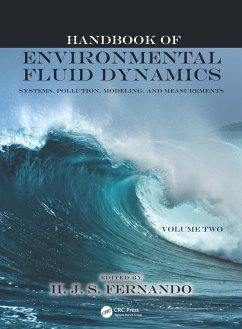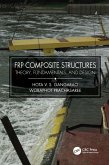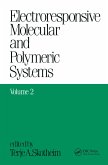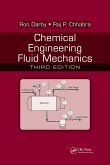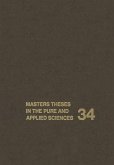Handbook of Environmental Fluid Dynamics, Volume Two
Systems, Pollution, Modeling, and Measurements
Herausgeber: Fernando, Harindra Joseph
Schade – dieser Artikel ist leider ausverkauft. Sobald wir wissen, ob und wann der Artikel wieder verfügbar ist, informieren wir Sie an dieser Stelle.
Handbook of Environmental Fluid Dynamics, Volume Two
Systems, Pollution, Modeling, and Measurements
Herausgeber: Fernando, Harindra Joseph
- Gebundenes Buch
- Merkliste
- Auf die Merkliste
- Bewerten Bewerten
- Teilen
- Produkt teilen
- Produkterinnerung
- Produkterinnerung
The Handbook of Environmental Fluid Dynamics presents the basic principles, fundamental flow processes, modeling techniques, and measurement methods used in the field, along with critical discussions of environmental sustainability related to engineering. This second volume covers the interactions between engineered structures and natural flows as well as the major topic of environmental pollution, with a focus on numerical methods, predictive modeling, and computer infrastructure developments. The book also looks at practical aspects of laboratory experiments and field observations that…mehr
Andere Kunden interessierten sich auch für
![FRP Composite Structures FRP Composite Structures]() Hota V. S. GangaraoFRP Composite Structures136,99 €
Hota V. S. GangaraoFRP Composite Structures136,99 €![Electroresponsive Molecular and Polymeric Systems Electroresponsive Molecular and Polymeric Systems]() Electroresponsive Molecular and Polymeric Systems156,99 €
Electroresponsive Molecular and Polymeric Systems156,99 €![Sandwich Structural Composites Sandwich Structural Composites]() Wenguang MaSandwich Structural Composites202,99 €
Wenguang MaSandwich Structural Composites202,99 €![Chemical Engineering Fluid Mechanics Chemical Engineering Fluid Mechanics]() Ron DarbyChemical Engineering Fluid Mechanics46,99 €
Ron DarbyChemical Engineering Fluid Mechanics46,99 €![Wiley Encyclopedia of Composites, 5 Volume Set Wiley Encyclopedia of Composites, 5 Volume Set]() Wiley Encyclopedia of Composites, 5 Volume Set1.929,99 €
Wiley Encyclopedia of Composites, 5 Volume Set1.929,99 €![Fundamental Mathematics and Physics of Medical Imaging Fundamental Mathematics and Physics of Medical Imaging]() Jack LancasterFundamental Mathematics and Physics of Medical Imaging111,99 €
Jack LancasterFundamental Mathematics and Physics of Medical Imaging111,99 €![Masters Theses in the Pure and Applied Sciences Masters Theses in the Pure and Applied Sciences]() Wade H. Shafer (ed.)Masters Theses in the Pure and Applied Sciences60,99 €
Wade H. Shafer (ed.)Masters Theses in the Pure and Applied Sciences60,99 €-
-
The Handbook of Environmental Fluid Dynamics presents the basic principles, fundamental flow processes, modeling techniques, and measurement methods used in the field, along with critical discussions of environmental sustainability related to engineering. This second volume covers the interactions between engineered structures and natural flows as well as the major topic of environmental pollution, with a focus on numerical methods, predictive modeling, and computer infrastructure developments. The book also looks at practical aspects of laboratory experiments and field observations that validate quantitative predictions and help identify new phenomena and processes.
Produktdetails
- Produktdetails
- Verlag: CRC Press
- Seitenzahl: 587
- Erscheinungstermin: 12. Dezember 2012
- Englisch
- Abmessung: 282mm x 221mm x 76mm
- Gewicht: 3357g
- ISBN-13: 9781466556010
- ISBN-10: 1466556013
- Artikelnr.: 37184934
- Herstellerkennzeichnung
- Libri GmbH
- Europaallee 1
- 36244 Bad Hersfeld
- gpsr@libri.de
- Verlag: CRC Press
- Seitenzahl: 587
- Erscheinungstermin: 12. Dezember 2012
- Englisch
- Abmessung: 282mm x 221mm x 76mm
- Gewicht: 3357g
- ISBN-13: 9781466556010
- ISBN-10: 1466556013
- Artikelnr.: 37184934
- Herstellerkennzeichnung
- Libri GmbH
- Europaallee 1
- 36244 Bad Hersfeld
- gpsr@libri.de
Harindra Joseph Shermal Fernando is the Wayne and Diana Murdy Endowed Professor of Engineering and Geosciences at the University of Notre Dame, with the primary affiliation in the Department of Civil and Environmental Engineering and Earth Sciences and a concurrent appointment in the Department of Aerospace and Mechanical Engineering. He has received numerous awards and honors, including a UNESCO Team Gold Medal (1979), Presidential Young Investigator Award (NSF, 1986), and Rieger Foundation Distinguished Scholar Award in Environmental Sciences (2001). He is a fellow of the American Society of Mechanical Engineers, American Physical Society, and American Meteorological Society and was elected to the European Academy in 2009. He serves on the editorial boards of Applied Mechanics Reviews (associate editor), Theoretical and Computational Fluid Dynamics (editor, 1997-), IAHR Journal of Hydro-Environment (associate editor), Physics of Fluids (associate editor) and EGS Journal of Non-Linear Processes in Geophysics (editor). He is also the editor in chief of the Journal of Environmental Fluid Dynamics. Professor Fernando has published more than 225 papers spanning nearly 50 international peer-reviewed journals.
Part I Engineered Systems and Anthropogenic Influence: Water Distribution
Systems. Groundwater-Surface Water Discharges. Fluid Mechanics of
Agricultural Systems. Desalination and the Environment. Bubble Plumes.
Scour around Hydraulic Structures. Flow through Urban Canopies. Flow
through Buildings. Bluff Body Aerodynamics and Aeroelasticity.
Wake-Structure Interactions. Urban Heat Islands. Part II Environmental
Pollution: Atmospheric Dispersion. Flow and Dispersion in Street Canyons.
Air Flow through Tunnels. Sound Outdoors and Noise Pollution. Riverine
Transport, Mixing, and Dispersion. Ocean Outfalls. Modeling Oil Spills to
Mitigate Coastal Pollution. Miscible and Immiscible Pollutants in
Subsurface Systems. Part III Numerical Modeling of Environmental Flows:
Turbulent Flow Modeling. Direct and Large Eddy Simulation of Environmental
Flows. Multiscale Nesting and High Performance Computing. Multiscale
Representations. Dispersion Modeling. Modeling the Urban Boundary and
Canopy Layers. Air Pollution Modeling and Its Applications. Mathematical
Models to Improve Performance of Surface Irrigation Systems.
Cyberinfrastructure and Community Environmental Modeling. Uncertainty in
Environmental NWP Modeling. Part IV Laboratory Modeling of Environmental
Flows: Physical Modeling of Hydraulics and Sediment Transport. Laboratory
Modeling. General Laboratory Techniques. Hot-Wire Anemometry in Turbulence
Research. Optical Methods and Unconventional Experimental Setups in
Turbulence Research. Part V Environmental Measurements: Hydrophysical
Measurements in Natural Waters. Flow Measurements in the Atmosphere.
Atmospheric Flux Measurements. Clear-Air Radar Profiling of Wind and
Turbulence in the Lower Atmosphere. Index.
Systems. Groundwater-Surface Water Discharges. Fluid Mechanics of
Agricultural Systems. Desalination and the Environment. Bubble Plumes.
Scour around Hydraulic Structures. Flow through Urban Canopies. Flow
through Buildings. Bluff Body Aerodynamics and Aeroelasticity.
Wake-Structure Interactions. Urban Heat Islands. Part II Environmental
Pollution: Atmospheric Dispersion. Flow and Dispersion in Street Canyons.
Air Flow through Tunnels. Sound Outdoors and Noise Pollution. Riverine
Transport, Mixing, and Dispersion. Ocean Outfalls. Modeling Oil Spills to
Mitigate Coastal Pollution. Miscible and Immiscible Pollutants in
Subsurface Systems. Part III Numerical Modeling of Environmental Flows:
Turbulent Flow Modeling. Direct and Large Eddy Simulation of Environmental
Flows. Multiscale Nesting and High Performance Computing. Multiscale
Representations. Dispersion Modeling. Modeling the Urban Boundary and
Canopy Layers. Air Pollution Modeling and Its Applications. Mathematical
Models to Improve Performance of Surface Irrigation Systems.
Cyberinfrastructure and Community Environmental Modeling. Uncertainty in
Environmental NWP Modeling. Part IV Laboratory Modeling of Environmental
Flows: Physical Modeling of Hydraulics and Sediment Transport. Laboratory
Modeling. General Laboratory Techniques. Hot-Wire Anemometry in Turbulence
Research. Optical Methods and Unconventional Experimental Setups in
Turbulence Research. Part V Environmental Measurements: Hydrophysical
Measurements in Natural Waters. Flow Measurements in the Atmosphere.
Atmospheric Flux Measurements. Clear-Air Radar Profiling of Wind and
Turbulence in the Lower Atmosphere. Index.
Part I Engineered Systems and Anthropogenic Influence: Water Distribution
Systems. Groundwater-Surface Water Discharges. Fluid Mechanics of
Agricultural Systems. Desalination and the Environment. Bubble Plumes.
Scour around Hydraulic Structures. Flow through Urban Canopies. Flow
through Buildings. Bluff Body Aerodynamics and Aeroelasticity.
Wake-Structure Interactions. Urban Heat Islands. Part II Environmental
Pollution: Atmospheric Dispersion. Flow and Dispersion in Street Canyons.
Air Flow through Tunnels. Sound Outdoors and Noise Pollution. Riverine
Transport, Mixing, and Dispersion. Ocean Outfalls. Modeling Oil Spills to
Mitigate Coastal Pollution. Miscible and Immiscible Pollutants in
Subsurface Systems. Part III Numerical Modeling of Environmental Flows:
Turbulent Flow Modeling. Direct and Large Eddy Simulation of Environmental
Flows. Multiscale Nesting and High Performance Computing. Multiscale
Representations. Dispersion Modeling. Modeling the Urban Boundary and
Canopy Layers. Air Pollution Modeling and Its Applications. Mathematical
Models to Improve Performance of Surface Irrigation Systems.
Cyberinfrastructure and Community Environmental Modeling. Uncertainty in
Environmental NWP Modeling. Part IV Laboratory Modeling of Environmental
Flows: Physical Modeling of Hydraulics and Sediment Transport. Laboratory
Modeling. General Laboratory Techniques. Hot-Wire Anemometry in Turbulence
Research. Optical Methods and Unconventional Experimental Setups in
Turbulence Research. Part V Environmental Measurements: Hydrophysical
Measurements in Natural Waters. Flow Measurements in the Atmosphere.
Atmospheric Flux Measurements. Clear-Air Radar Profiling of Wind and
Turbulence in the Lower Atmosphere. Index.
Systems. Groundwater-Surface Water Discharges. Fluid Mechanics of
Agricultural Systems. Desalination and the Environment. Bubble Plumes.
Scour around Hydraulic Structures. Flow through Urban Canopies. Flow
through Buildings. Bluff Body Aerodynamics and Aeroelasticity.
Wake-Structure Interactions. Urban Heat Islands. Part II Environmental
Pollution: Atmospheric Dispersion. Flow and Dispersion in Street Canyons.
Air Flow through Tunnels. Sound Outdoors and Noise Pollution. Riverine
Transport, Mixing, and Dispersion. Ocean Outfalls. Modeling Oil Spills to
Mitigate Coastal Pollution. Miscible and Immiscible Pollutants in
Subsurface Systems. Part III Numerical Modeling of Environmental Flows:
Turbulent Flow Modeling. Direct and Large Eddy Simulation of Environmental
Flows. Multiscale Nesting and High Performance Computing. Multiscale
Representations. Dispersion Modeling. Modeling the Urban Boundary and
Canopy Layers. Air Pollution Modeling and Its Applications. Mathematical
Models to Improve Performance of Surface Irrigation Systems.
Cyberinfrastructure and Community Environmental Modeling. Uncertainty in
Environmental NWP Modeling. Part IV Laboratory Modeling of Environmental
Flows: Physical Modeling of Hydraulics and Sediment Transport. Laboratory
Modeling. General Laboratory Techniques. Hot-Wire Anemometry in Turbulence
Research. Optical Methods and Unconventional Experimental Setups in
Turbulence Research. Part V Environmental Measurements: Hydrophysical
Measurements in Natural Waters. Flow Measurements in the Atmosphere.
Atmospheric Flux Measurements. Clear-Air Radar Profiling of Wind and
Turbulence in the Lower Atmosphere. Index.

